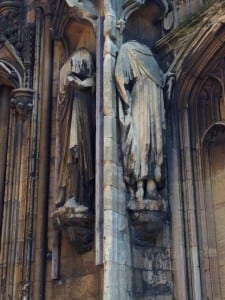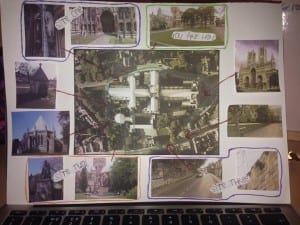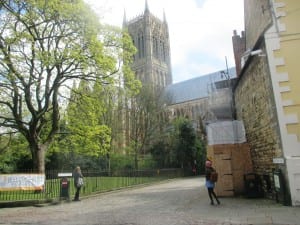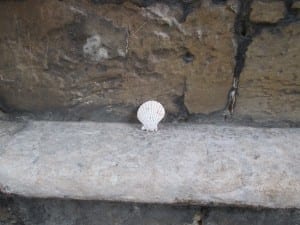Framing Statement
Our Site-Specific Performance module began back in January 2015, with the chosen site of Uphill Lincoln. It was a tough, yet eye-opening experience which challenged and contrasted the theatrical conventions we were thus far used to. Given the opportunity to explore uphill Lincoln and its surroundings, our group chose the cathedral grounds as our site route. We specifically focused on the ideals of walking round in a loop, following the route back to the green where the audience first begin their journey. This route underlined our piece as a metaphorical representation of the life cycle: how we grow, who we meet and how our paths interlink. Most of these things we take for granted and our site piece aimed to bring these questions to the forefront – letting the audience take an individual journey to discover and reflect upon all the little things that surround them.
‘All precious things, discovered late’ was an audio-assisted journey surrounding the grounds of the Cathedral and through Castle Square. Since the very beginning of our process, we had all been fascinated by the amount of perspectives people had on the Cathedral, whether that was through story-telling, myths, personal experiences or overheard conversations. As stated by Persighetti, Site-Specific work has to ‘deal with, embrace, and cohabit with existing factors of … architecture, chance … incident.’ (2000, 12). Relating this to our piece, we went into this challenge head on and decided to ‘embrace’ the site as a performance, adding layers to its pre-existing history and allowing for small suggestive ‘incidents’ to help guide us on our serendipitous process.
As our piece developed, it became apparent that we had generated an underlying theme of a pilgrimage of life: looking at the place afresh and being able to recognise if there had been any change. Our audio aimed to connect one on one with the audience member as a companion, telling them snippets of their own life, as well as highlighting key points of significance on the journey. Incorporating Alfred Lord Tennyson’s poem The Cradle Song and the Seven Ages of Man speech from As You Like It, we were able to create a solid route which is an appreciation of everything around them – the same way they should in life.
Our Performance took place on the 6th May at 11.00am, lasting approximately 20-30 minutes. The audio for our piece was uploaded to our event two days in advance, giving them the opportunity to listen to it beforehand if they wish, or waiting until the day to experience it. It started informally at the green with a picnic blanket, with Jess and Megan welcoming people to the performance and presenting them with the gift of a scallop shell as a symbol of acceptance before embarking on their journey.
An Analysis of Process
Opening our eyes to the ideas of ‘space’
Whilst conventional theatre takes a play and refines its meaning into the given space, Site Specific involves making a performance that ‘responds to a place from the perspective of an outsider’ (Govan, 2007, 121). Performance artists look at a space and draw meaning from it – whether it be cultural, historical or philosophical, it generates a narrative for new perspectives to arise. It can happen anywhere at any time and for any length. Henceforth when reading Mike Pearson’s Site-Specific Performance, I realised that spaces around us, whether neglected or bustling, withhold meaning on their own. It does this by engaging with ‘site as a symbol, site as storyteller [and] site as structure’ (Wilkie, 2002, 158). Simple moments of a loud conversation, a torn up piece of paper on the floor or an interesting architectural design all have a story to tell. Site-specific performers can then take these as documentation and reinvent a new or reflective meaning for those who are visiting or those whom know it extremely well.
Site, representation and perspectives
When originally exploring the site, I took many photos of documentation to reflect what intrigued or inspired me about the uphill surroundings. Having lived in Lincoln for over a year, it would be more than likely that I would carelessly walk through the site without really taking in every aspect of its culture and history. As described by Phil Smith in the chapter:The Handbook of Drifting, he encourages that individuals who partake in Guy Debord’s ‘derive’ (also known as a drift) must look for a theme: textures, the old, the new; looking for meaning in everything. This type of walk described as ‘drifting’ aims to detach us from our comfort zone and take chances on where a walk may take us. Debord developed a concept known as ‘pyschogeography’ – intertwining our conscious everyday critical thinking as a ‘playful encounter with [a site]‘ (Govan et al, 2007, 141).
Arlene Sanderson talks about ‘Wrights and Sites’ for those interested in the performed activity of ‘walking’. A manifesto was created which depicted how they wanted to generate walking that ‘engages with and changes the city, it recruits the arts not as passive expressions, but as the active changes of it.’ (1991, 70). Me and Megan decided to act upon the idea of playfulness and decided to view the courtyard as if from a child’s perspective. The benches near the well were the safety zone, whilst the shape formed on the floor further away from the well was the deep dark depths of the underworld. We found that we shared a common interest in exploring the themes of ‘playfulness’ and ‘perspectives’ with Charlie and Jess, and this formed our group – on the basis of our ideas.
Experiencing Audio Performances
After our last session, I went home and listened to a few audio pieces, mainly The Guardian Culture Podcasts, which are meant to be listened to independently as an individual type of performance art. Now, when originally asked to participate in something like this, I wondered how an earth something like listening to audio could be classed as a ‘performance’. We listen to audio through our headphones most days, don’t we? Some listen to music whilst walking to various locations, some to podcasts of their favourite radio shows and much more, yet I had never once considered this to be a performance.
The first audio I listened to was read by Adrian Howells and is number eleven in part of the Everyday Moments Podcasts, whereby audience members listen to this ‘audio drama’, in order for them to participate in and become their very own ‘private performance.’ (Howells, 2011). Each audio in this series are to be listened to at different moments throughout the day. This particular one is to be listened to in the early hours of the morning whilst sipping on a hot drink. His welcoming and down to earth tone of voice really made me feel at ease and by the end of the audio, I felt like I knew him.
I also listened to Fuel Theatre, in their collection of ‘While You Wait‘ for something, which is supposedly there to produce ‘a moment of reflection’. (Fuel Theatre, 2015). I took part in the first one called ‘Waiting Now’ and found something very intriguing about this piece. Unlike the Everyday Moments Podcasts being audio from one individual, Fuel Theatre culminated various different sounds, recordings, and telephone calls. There were lots of pauses to give the audience member time to reflect, which I found really quite intriguing as a performative action.
Initial ideas and sparks of inspiration
Having formed our groups, it became quite a struggle to spark initial ideas of where to go and what to do first. We decided to go back to basics and think back to previous tasks we had done whilst exploring Uphill Lincoln. We thought back to last weeks’ session of misguided tours and decided to write down any ideas or places that seemed to spark any of our interests during the day. Here are some of the things we listed to look at or research further:
- Looking at the space with a child-like mindset – interview children about some of the pictures we have taken surrounding the Cathedral?
- The Archways around the Cathedral – Stepping back in time, like a time capsule: the old and the new.
- The Hut, or ‘pixie’ hut as we referred to it outside the Cathedral – what myths does it have. Could we combine fact and fiction into our piece?
- Alfred Lord Tennyson statue – research some of his poems and reflect them back into the space in some way.
- The picture of the man’s head coming out of the wall. What is his story?
- The theme of ‘walking’ and going on some sort of tour.
This came from the inspiration of Robert Wilson’s ‘Walking’ in North Norfolk. Where they were told ‘don’t be afraid to walk too slowly’ (Hyder Dewachi, 2012). A journey that changed the way the viewed the space. They instilled a large tunnel in the country which deprived them of visualising the space around them, yet allowed them to use their other senses more vividly.
Interviews and collected recordings
In development of our ideas from our last session, we felt it might be quite difficult in obtaining recordings of children, so we decided to switch up our idea and interviewed people of various age ranges, some questions referring to the picture below. We really wanted to pay homage to the variety of people that inhabit the space and their perspectives upon the site.
One of our questions was ‘what do you automatically think of when you see this picture and how would you describe this if you were conducting a tour?’ Looking back now, it is clear to see that these questions were particularly vague and open-ended, thus meaning not all of the recordings had the impact we had quite hoped to achieve. Nevertheless, here is an example of one of the first recordings we have as documentation of our interviews:
After writing a brief script together, and as I was chosen as designated voice for the audio, I began to record a rough idea of what we had written. For a first time recording, it was successful in the way that it was clear and directional. One the other hand, it was recognisable to note that my tone of voice was too robotic – like that of a stereotypical ‘tour-guide’. Since this was not our intention, we decided to go back to the drawing board and spent hours choosing specific wording to make our audio more successful.
Feedback upon our initial ideas
Once we had decided on the specific areas we intended to use as part of our tour, Charlie created this map – pinpointing the significant places to listen to the audio and what way to follow the route:
We felt that the audio on its own was not strong enough to earn its right to be a ‘performance’. Thinking along the lines of childhood creativity, we thought it might be interesting to link the thoughts of the audio into a short activity. For example, in our second site (Tennyson statue) we had a recording of a young girl reading the ‘Cradle Song’ poem. We then wanted our audience to reflect upon how they felt about it, by drawing with chalk on the floor.
When receiving feedback from our lecturers, they believed that audience members given the task to do something – won’t willingly do it, or we would curate a piece that puts pressure on the audience. Conan suggested that they may worry whether they are doing the right thing and may feel a little patronised. They also felt that although the map was detailed, it would take away from our ‘observe’ everything intention. Whilst Conan and Rachel were intrigued by our layers of perspectives, they suggested that if we were to work more solidly on constructing a detailed audio script, then that would be the performative experience itself. Rachel also suggested that if we were interested in playfulness, then gifting the audience and being generous to them may be the way to approach our work. This lead us to research into Proto-type’s performance of ‘Fortnight’ which became a huge influence on our work. Their work is ‘an exploration of what it means to ‘be here, now’. Part theatrical magic, part philosophical treasure hunt’ (Proto-type, 2015). Interweaving with that of our subtle ‘orchestrated serendipities’.
We had been discussing perhaps the use of bringing in another text that was relevant to the stages of life. It immediately reminded me of Shakespeare’s ‘As You Like it’ and Jacques’ notorious Seven Ages of man speech. In order to trial this we recorded an elderly gentlemen reading the speech, as presented below:
Taking a change of direction
Over Easter I wrote up our detailed script (Audio-Script-First-Draft) and highlighted points that perhaps needed reworking or more substance added to them. Once we met up to go through this, it became apparent that our main theme was to be gifting or making subtle coincidences of ‘orchestrated serendipity. After having a read through of our first drafted script, Rachel felt that it was almost becoming like a pilgrimage. Not in the religious sense, more to experience something through new eyes and for things to have ‘changed’ for them along the way. As we noticed that we were gathering interviews from people of all ages, we began to think of the audio as rather a ‘journey’ than a ‘tour’; to develop into some sort of reflection or become a physical metaphor of our human life cycle. Having now incorporated Shakespeare’s ‘Seven Ages of man’ speech, we wrote down (without hammering it in too hard) the specific part of our site that reflected each stage of the speech
The Judgement Doors at the beginning represent inquiry – The moment of hesitation before taking a leap to participate in something.
- At first ‘the infant’ – Tennyson’s Cradle Song.
- The ‘whining school-boy’ – The sound of school children and reflective questions on childhood.
- Then the ‘lover’ – The sound of wedding bells with confetti scattered on the floor.
- A ‘soldier’ – Castle Square, the people walking in the space become the ‘marchers’.
- The ‘justice’ – Exchequer gate and the library above, along with questions reflecting life up until this point as they pass through the gate.
- The ‘lean and slippered pantaloon’ – Here there would be further rhetorical questions about their journey prior to our performance.
- Lastly – ‘second childishness and mere oblivion’ – The speech itself read aloud by an elderly gentleman.
Audio and the implementation of Scallop Shells
On our trial run, we suggested our idea of ‘gifting’ our audience with Scallop Shells, as an acceptance of embarking on our journey. This idea stemmed from that of ‘Crabman and Signpost’ in their A Sardine Street box of tricks, whereby they asked their audience to make a mark in the salt to confirm they were ready.
Our first audio recording was a complete shambles and our feedback completely shot down all the hard work we had previously spent hours on. What we hadn’t realised was that by being directional, we had become too forceful and placed pressure on the audience. There were words which would not be used in everyday conversation and some directions were wrong. However, personally, I feel this was a very important stage in our process in order to get back on to our original ‘playful’ tone of companionship.
For our second audio recording, we wanted it to be as authentic to our everyday conversation as possible. Therefore we recorded our own process of discussion:
We then transcribed our rehearsal, ready for our recording. Once ready to record, I then spoke our words as casually as possible, as if talking to Megan, Jess or Charlie.
Janet Cardiff’s audio walk ‘The missing voice’ bestows an insight into familiar spaces that are perceived as ‘new’ when ‘other presences and resonances are called into being’ (2001, 5). When our audio suggests moments from their life: ‘I came here the other day’ could make them question the last time they walked through that same space. A performance piece therefore ‘owe[s] its character not only to the experiences it affords as sights, sounds, etc. but also to what is done there as looking, listening, moving” (Pearson, 2010, 16).
Here is Audio One of our final collection to ‘All precious things, discovered late’:
Naming our piece and marketing the event
‘All precious things discovered late’ is a line from one of Tennyson’s poems called ‘The Arrival’ in his collected works ‘The Daydream’ (1842). We felt that this line within the poem wholly encompassed our reflections upon our audio journey – making them think in a philosophical way and appreciate precious moments in life. This made me think back to Duncan Speakman’s ‘subtlemob’: ‘As if it were the last time’. It opened people’s eyes to the everyone around them and made them think: what is their story? Are they participating in the same thing I am? The power in audio can be so overwhelming and we had hoped that through our journey, people would feel some sort of emotion, especially at the end: the detachment of the Audio’s voice saying ‘This is where I leave you now’; making the audience feel very alone.
Our event was published on 17th April via this link: https://www.facebook.com/events/729015657221978/ and invites to this were predominantly students. On here we advertised it as an ‘eye-opening audio assisted walk around the grounds of the cathedral and passing through castle square.’ (All precious things, discovered late, 2015). Originally, we had intended for our audio files to go live at midday on the 2nd May, however, with difficulties getting the audio polished, we had to push the date back to Monday 4th – which still allowed time for people to get in contact if they were having any technical issues.
Trialling the audio and our final run through
Our last run through went successfully and this was the point we felt extremely proud of the work we had produced. The feedback this time were only picky things that stand out such as some words needed changing to sound more realistic and timing for paues need to solved, but apart from that everything else worked very well.
Performance Evaluation
On the day of our performance, the weather was miserable, however, this did not deter us. Before arrival of our audience, we had pre-planned serendipitous happenings around our site, such as confetti for marriage; they may not get the link, but if they do it produces a uniquely special moment for that individual‘ and can become a lasting part of the story of that place” (Pearson, 2010, 16). Due to the rain, we only had two audience members. In a way this kind of worked in our favour – as it presented them with a more personal journey. Having the audio on their own devices means that they may stumble back upon the audio in the future and be able to reflect upon or re-do the audio, to see if it has changed their perspective of the site or themselves. If we were to expand our performance further, I feel that our ‘roles’ within the performance could be more succinct. Perhaps have more offerings of gifts in order to obtain our style of generosity?
Allison Hui depicts how Site-Specific ‘works of art are meant to provoke affective responses … by seeking to change perspectives and spark new views of social relations or social spaces.’ (2011, np).Through life, wherever we go, there are changes; in ourselves, the site and the way in which we view it. With the symbol of Scallop Shells representing our journey, if audience members come across another shell, it invites the possibility of reflection upon ‘All precious things, discovered late’ and the experience may, once again, be reignited.
Bibliography:
Crab Man and Signpost. (2011) A Sardine Street box of tricks. United Kingdom: Blurb Inc.
CIRCUMSTANCE (2009) OFFICIAL “as if it were the last time” – 2009 subtlemob video. [online video] Available from:https://www.youtube.com/watch?v=FY6S4GkCZ9c [Accessed 10th February 2015].
Etchells, T. (1999) Certain Fragments: Contemporary Performance and Forced Entertainment. London: Routledge.
Fuel Theatre (2015) While You Wait. [online]. London: Fuel. Available from: http://fueltheatre.com/projects/while-you-wait [Accessed 13th February 2015].
Govan, E., Nicholson, H. and Normington, K. (2007) Making a Performance: Devising Histories and Contemporary Practices. New York: Routledge.
Holloway, L. and Hubbard, P. (2001) People and place: the extraordinary geographies of everyday life. Essex: Pearson Education Limited.
Hui, A. (2011) Art as an everyday intervention: shifting times, places and mobilities in the pervasive media performance project “Fortnight”. The Association of American Geographers’ Conference, New York, 25 February 2012 [unpublished].
Hydar Dewachi (2012) Robert Wilson “Walking” [online video] Available from https://www.youtube.com/watch?v=T8ih4GddMc4 [Accessed 10th March 2015].
Kenneally, F. (2015) All precious things, discovered late. [online] Available from: https://www.flickr.com/photos/129602943@N07/albums [Accessed 6th May 2015].
Kenneally, F., Langer, M., Martin, J. and Robert, C. (2015) All precious things, discovered late. [performance] Fleur Kenneally, Megan Langer, Jess Martin and Charlotte Roberts. (dir.) Lincoln: Lincoln Cathedral, 7 May.
Lees, G. Petralia, P. (2011) Fortnight. [performance] Proto-Type Theatre. Bristol: 2nd – 15th May.
Mochinet (2000) The Daydream. [online] Available from: http://www.mochinet.com/recitals/daydream.html [Accessed 16th February 2015].
Pearson, M. (2010) Site-Specific Performance. London: Palgrave Macmillan.
Sanderson, A. (1991) A Manifesto for a New Walking Culture: ‘Dealing with the City’. In: Wrights and sites. United States: Washington Preservation Press.
Schechner, R. (3rd ed) (2010) Performance Studies: An Introduction. London: Routledge.
Smith, P. (2010) Mythogeography: A guide to walking sideways. London: Axminster Triarchy Press.
The Guardian (2011) Everyday Moments 11: audio drama for private performance. [online]. London: The Guardian. Available from: http://www.theguardian.com/culture/audio/2011/nov/21/everyday-moments-podcast-adrian-howells [Accessed 13th February 2015].




